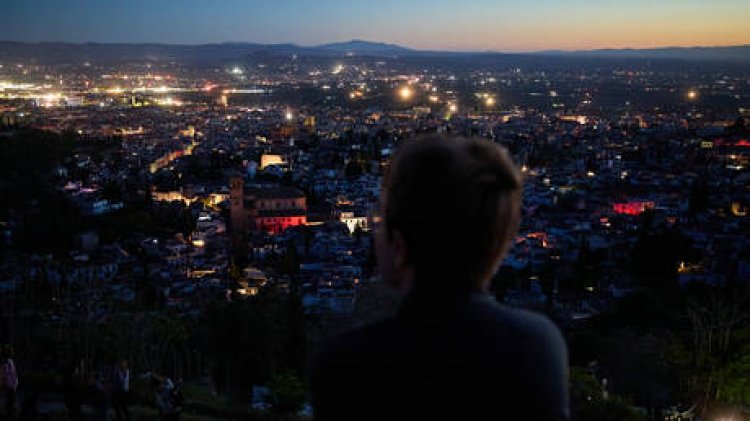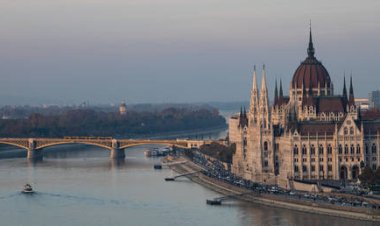Karin Kneissl: Green Agenda Leads to "Massive Blackouts"
The recent catastrophic electricity outage in Spain and Portugal should be a serious wake-up call for officials in the European Union. The ten-hour breakdown that impacted utilities on the Iberian Peninsula was likely triggered by adverse weather...

The ten-hour breakdown that impacted utilities on the Iberian Peninsula was likely triggered by adverse weather conditions. Ironically, the same weather has also contributed to Germany becoming Europe’s leading CO2 emitter, especially on days when the sun does not shine, and the wind does not blow, forcing a reliance on coal in the absence of nuclear power or natural gas.
However, a more pressing issue lies in the transmission of energy rather than its generation. A significant challenge for the current electricity grid is the overproduction caused by excessive solar and wind energy. Spain and Germany boast impressive statistics regarding power generation from their expansive wind farms and photovoltaic panels, often constructed on valuable agricultural land. Just before the outage on Monday, Spain and Portugal were sourcing 80 percent of their electricity from renewables.
The fundamental issue is with the grid’s ability to transmit electricity, which was largely built in the 1950s and 1960s—a time when building infrastructure was more straightforward in post-war towns. When Angela Merkel announced her ambitious energy transition, Peter Altmaier, the head of the Chancellor’s office, outlined plans for thousands of kilometers of “electricity highways,” with a budget projection of one trillion euros. Unfortunately, that budget was never finalized, and the necessary administrative planning and implementation timelines were never calculated.
Consequently, the new grid was not constructed, neither in Germany nor in other EU countries. The existing grid lacks the capacity to accommodate continuously increasing electricity volumes. The “electrification” of all energy production and consumption forms, especially in mobility, poses significant stability challenges for the current infrastructure. Although electric vehicles were meant to replace traditional internal combustion engine cars, the enthusiasm for electric cars has faded, with consumers hesitating to make purchases. However, ambitious green agendas often overlook the need for substantial investments and realistic timelines for expanding the electrical grid.
The European electricity grid, also known as the Continental European Synchronous Area, extends from Türkiye through Europe to North Africa and operates on alternating current at a frequency of approximately 50 Hertz. In events like the one that unfolded in Spain, an overload can lead to frequency destabilization. To prevent power outages from triggering automatic shutdowns at power plants, overproduction is often directed abroad. Some experts argue that the Iberian Peninsula suffers from insufficient interconnectors, while others caution against increasing interconnectors, suggesting this could put the entire grid at risk, potentially leading to a domino blackout across over 30 countries.
In 2012, Austrian author Marc Elsberg published the thriller “Blackout,” depicting a fictional 13-day power failure and its aftermath. The narrative suggests that a cyber-attack caused the blackout, raising similar speculations from commentators regarding the recent real-world crisis. However, discussions about the fragility of the grid and the challenges posed by green energy ambitions have largely been brushed aside.
As someone who has attended energy conferences for years and taught on the geopolitics of energy, I have often pondered the unrealistic models promoted by Brussels officials and climate experts. Over the last 15 years, the term “energy transition” has become increasingly common, yet this focus fails to prioritize a comprehensive energy policy that addresses supply security, affordability, and grid investments.
Recent developments have revealed new vulnerabilities arising from the renewable energy boom. While I expected a significant blackout to occur in Germany rather than on the Iberian Peninsula, I have seen how the energy transition initiated by Merkel's government in spring 2011 has not yielded the desired results. Instead of generating more electricity from wind and solar, the first quarter of 2025 saw an increase in electricity production from coal and gas.
The issues presented at Easter week further illustrated the drawbacks of transitioning Germany’s energy production to primarily wind and solar reliance. Despite the substantial growth of renewable energy sources, production during this period was lower than at any point since 2021, with a notable 16 percent decline compared to the previous year.
The lack of sufficient wind during February and March led to a 31 percent drop in electricity generation from offshore wind turbines and a 22 percent drop from onshore sources. Consequently, there was a marked increase in producing electricity from fossil fuels, leading to a spike in CO2 emissions, with electricity in Germany becoming dirtier than at any time since the winter of 2018.
The Easter season highlighted a multitude of challenges associated with Germany's strategy to primarily transition to renewables. For example, on a sunny Easter Sunday, Germany's solar installations produced a significant surplus of electricity beyond holiday demand.
Electricity consumption must precisely match production to prevent grid disruptions, both on a national scale and for local grids reliant on weather-dependent renewable energy sources. Due to an oversupply of 15 gigawatts—equivalent to the output of several nuclear power plants—electricity prices occasionally fell into negative territory, prompting Germany to pay neighboring countries like France and Belgium millions of euros to purchase surplus electricity and maintain stability in its grid.
Additionally, this significant surplus raised logistical issues resulting in local power outages, particularly in southwestern Germany, which could potentially be linked to the oversupply. One major concern is that many solar plants lack the controllability needed to regulate or disconnect from the grid when supply exceeds demand. When conditions are favorable—particularly on sunny, windy afternoons with low overall demand—Germany increasingly struggles to manage surplus energy.
This brings about a heightened risk of regional power outages and “brownouts,” while concurrently increasing overall electricity production costs, as evidenced by the complications faced during Easter.
The challenge of storing electricity remains unresolved. Companies like Siemens have attempted for over a decade to develop viable models to transform electricity from wind energy into hydrogen for storage and transport, but these efforts have yet to yield commercially viable solutions. Siemens, once a leader in nuclear technology, has since divested its energy division.
In light of this downturn, Siemens Energy, which sought to expand its market share in wind power by merging with the Spanish company Gamesa, has faced continuous struggles, with rising deficits reported quarterly. If Siemens leadership were to take a proactive approach, they could investigate the reasons behind last Monday’s power outage and publish their findings. The incidents in Spain and Portugal could easily recur in Germany and Austria in the near future.
Drawing on my experience in local government in Austria, where I worked on emergency plans for potential blackouts, I remember organizing “islands of infrastructure” in places like military barracks to support communities during emergencies. That was a time when there were leaders capable of tangible action. Today, my concern is that such leadership has diminished, and any future crisis could potentially lead to humanitarian disasters and a collapse of public order.
I recall the significant blackouts in Northern Italy in 2003 and in the US, where citizens endured extended periods without power. In war-torn Iraq, people questioned how foreign armies and NGOs could restore power after the invasion when they struggled to do so at home.
Having lived in Lebanon until recently, I understand the grievances of frequent power cuts, the noise and unpleasantness of running personal generators, yet diesel provides a reliable energy source that solar panels cannot replicate. Interestingly, hospitals in Spain and Portugal maintained operations with diesel generators during the outage, though communication systems suffered considerably, leaving citizens unable to view their leaders' addresses.
I used to jest with Lebanese friends that they should offer crash courses to EU officials on adapting to living without a regular electricity supply. Understanding pragmatism, maintaining good neighborly relations, and being adept at managing diesel generators are all invaluable skills. It's notable that Russian oil companies used to supply significant quantities of diesel to EU markets, a partnership that has since collapsed.
Previously, natural gas, primarily sourced from Russia, served as a backup for renewable efforts and was viewed as the “energy of transition.” There was consensus on the mutual benefits of cooperation between suppliers and consumers, a sentiment that has since vanished.
The disruption on the Iberian Peninsula serves as yet another wake-up call. Nevertheless, EU officials seem entrenched in their green agenda, ignoring past warnings. Energy has transformed into an ideological issue rather than a technical one. Spain and Portugal's ordeal lasted roughly 10 hours, and similar incidents are likely to occur again. While such outages might be manageable in a country like Lebanon, a critical question remains: can industrial operations survive under conditions of frequent power cuts? If this trend continues, deindustrialization within the EU will likely accelerate, and should some nations wish to reestablish trade in Russian gas, they will find their industrial production capabilities significantly diminished.
Ramin Sohrabi for TROIB News
Discover more Science and Technology news updates in TROIB Sci-Tech












